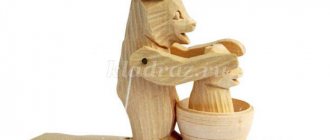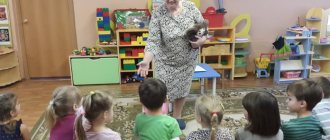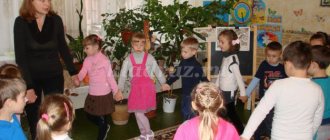Summary of educational activities for speech development in the middle group “Red spring with flowers”
Summary of GCD
on speech development in the middle group
"Red spring with flowers"
Summary of GCD
on speech development in the middle group “Red spring with flowers”
Purpose: Getting to know spring and summer flowers
Tasks:
1.Remember the name of the flowers, the features of their structure.
2. Continue to develop coherent speech, improve the grammatical structure of speech, and activate the subject and verb vocabulary.
3. Foster love and respect for nature.
Material:
a model of a forest clearing, pictures with flowers, a “seven-flowered flower” model, large puzzles with flowers.
Preliminary work:
looking at illustrations of flowers and talking about them. Reading fairy tales: A. Tolstoy “The Scarlet Flower”, “The Seven-Flower Flower”, didactic game: “When does this happen?”
Progress of the lesson:
IN:
Children, look what a beautiful spring flower the sorceress gave me just now. Whoever a leaf from a flower falls into his hand must say any word about spring.
D:
Sun, warmth, grass, flowers, rain, rainbow, buds on trees, puddles.
IN
: Well done. Guys, look, there’s something written on this piece of paper. Yes, this is a letter from the good sorceress. And she invites us to play hide and seek, I will ask riddles, and you guess them, and then we will find out what the sorceress hid from us in the forest clearing.
D:
Let's.
IN:
Listen carefully:
Puzzles
White peas on a green stem.
D:
Lily of the valley
IN:
Rye is earing in the field. There, in the rye, you will find a flower. Bright blue and fluffy, It’s just a pity that it’s not fragrant.
D:
cornflower
IN:
Sisters stand in the meadows - Golden eye, white eyelashes.
D:
Daisies
IN:
Eh, bells, blue, with a tongue, but no bells.
D:
Bells
IN:
The sun is burning the top of my head, wants to make a rattle.
D:
Poppy
IN:
I am a herbaceous plant with a lilac flower. But change the emphasis - And I turn into candy.
D:
Iris
IN:
I turn white like a fluffy ball in a clean field, And the breeze blew - A stalk remained.
D:
Dandelion
IN:
Over the meadow parachutes swing on a twig.
D:
Dandelion
IN:
A sprout breaks through, an amazing flower. It grows out from under the snow, the sun looks and it blooms.
D:
Snowdrop
IN:
The face is fragrant, and the tail is prickly.
D:
Rose
IN:
Cups and saucers do not sink or break.
PHYS.
A MINUTE: “ Our scarlet flowers”
Our scarlet flowers Bloom their petals. (Smoothly raise our hands up.) The breeze breathes slightly, the petals sway. (Swinging arms left and right.) Our scarlet flowers Close their petals, (Squat down, hide.) Shake their heads, (Move their heads left and right.) Quietly fall asleep.
IN:
Guys, what flowers do you like? What do they need to grow? Can you help me tell about this?
Game "Tell about your favorite flower."
(children choose any picture with a flower and tell it).
D:
This is a dandelion, it can be found both in the forest and in the city on the sidewalk. He is one of the first to grow up. Its head is yellow. The stem is round and tube-like. The dandelion will be yellow for a while, and then its head will turn white, etc. (tell the story with the help of the teacher)
IN:
Thank you guys for the interesting stories about flowers.
And now we will hold a competition
Game "Collect the picture"
(children are divided into two teams and collect large puzzles and fix the names of colors)
IN:
Guys, today you were attentive, pleased with your answers, and helped tell us about flowers. I hope the good sorceress heard everything and will please us this spring and summer with a wide variety of flowers.
Get text
Speech therapy summary for the middle group on the topic “First spring flowers”
Theme “First spring flowers”
Lesson 3
Correctional educational tasks.
Expansion and clarification of the dictionary on the topic “First spring flowers.” Improving the grammatical structure of speech (formation and use of the plural form of nouns), reading and typing skills, sound-letter analysis.
Corrective and developmental tasks.
Development of visual gnosis and constructive praxis, general speech skills, articulatory, fine and gross motor skills, creative imagination, intonation expressiveness.
Correctional and educational tasks.
Formation of skills of cooperation, interaction, goodwill, independence, initiative, desire to be fair. Cultivating a love for nature.
Equipment.
A container with details of a planar image of a snowdrop, a ball, a pot with a blooming coltsfoot, cards with the letters A, U, O, I, T.
Progress of the lesson
1. Organizational moment.
The speech therapist meets children at the door of the office with a container in his hands.
Children select one snowdrop piece from the container and go to the carpet maker. Speech therapist.
Name the parts of the flower that you took. 1st child. Stem. 2nd child. Flower. 3rd child. Leaf. 4th child. Bud. Speech therapist. Make an image of a snowdrop. Children complete the task.
2. Narrating the poem “Snowdrop”.
The speech therapist invites the children to admire what a beautiful snowdrop they have made, and to tell everyone a poem about it.
Children.
The very first, the most subtle There is a flower with the name tender. Like a ringing drop of hello, It’s called a snowdrop. (Then you can invite the children to take turns reciting the poem.)
Speech therapist. Do you remember that you can’t collect snowdrops in the forest? Why? What will happen if people collect rare flowers? Children. They may disappear. Speech therapist. Right. We will not collect rare flowers in the forest. You can try growing them in your garden. Or you can photograph or draw them.
3. Game “One - Many” (with a ball).
The speech therapist invites the children onto the carpet and takes the ball.
Speech therapist.
And now the ball game “One - Many”. I will name a part of a flower or a flower and throw the ball to one of you. The one who catches the ball must name several of these parts of the flower or flowers. (Throws the ball.)
Stem. 1st child. Stems. Speech therapist. Leaf. 2nd child. Leaves. Speech therapist. Bud. 3rd child. Buds. Speech therapist. Flower. 4th child. Flowers. Speech therapist. Petal. 1st child. Petals. Speech therapist. Snowdrop. 2nd child. Snowdrops. Speech therapist. Crocus. 3rd child. Crocuses. Speech therapist. Primrose. 4th child. Primroses. Speech therapist. Well done! Give yourself a clap.
4. Game “What’s extra?”
The speech therapist invites the children to the table.
Speech therapist. And now the game “What’s extra?” I will name plants or what needs to be done with them, and you will determine which word is superfluous and why. Crocus, cabbage, snowdrop, anemone - what's extra? Children. Cabbage. Speech therapist. Why? Children. This is a vegetable. Speech therapist. What about everything else? Children. These are spring flowers. Speech therapist. Right. Cactus, coltsfoot, snowdrop, crocus - what's extra? Children. Cactus. Speech therapist. Why? Children. It grows at home in a pot. Speech therapist. What about the rest of the plants? Children. In the forest. Speech therapist. Right. Draw, photograph, collect, admire - what word is superfluous? Children. Gather. Speech therapist. Why? Children. Spring flowers cannot be collected. Speech therapist. Right. Well done.
5. Breathing exercises. Exercise
The speech therapist takes a pot with a blooming coltsfoot and invites the children
to go out onto the carpet again.
Speech therapist.
And now a breathing exercise. You should smell the flowers and slowly inhale air through your nose. Then you need to hold your breath, and then, as you exhale, say: “The flowers smell so delicious!” See how I do it. Next, each child performs the exercise under the supervision of a speech therapist.
6. Exercise “Repeat after me.”
The speech therapist invites the children to the mirror and offers to do 1-2 exercises from articulatory gymnastics for whistling sounds, and then takes out cards with individual tasks and asks each child to repeat the text of the task. Children can be assigned to monitor the correct completion of the task by their comrades and evaluate each other’s work.
7. Game “Live sounds”.
The speech therapist gives the children cards with letters.
Speech therapist. And now the game “Living Letters”. I gave you cards with letters. Name them. 1st child. A. 2nd child. U. 3rd child. O. 4th child. T. Speech therapist. Right. And now I will name the syllables. The letters that make up these syllables should come to the board. At, from, ut, ta, then, tu. Children complete the task.
The speech therapist monitors the correctness of its implementation. If mistakes are made, the speech therapist invites the children to correct them themselves. Children can be asked to decide for themselves which syllables should be made.
8. End of class.
[
Assessment of children’s work.]
The speech therapist collects cards with letters, invites the children to sit on chairs and talk about what they did in class, what games they especially liked.
Lexical work: introduce children to the use of words in a figurative meaning.
Formation of the grammatical structure of speech: develop children’s ability to construct phrases with a given word.
Nurturing the sound culture of speech: develop children’s ability to identify sounds at the beginning, middle and end of a word; the ability to lay out the sound pattern of a word.
Development of coherent speech: develop children’s ability to compose a story from a picture using a plan.
Development of social skills: development of the ability to work in a team, negotiate and cooperate with each other.
Lesson materials
♦ Family photographs of children brought from home, in which they and their relatives are depicted against a background of flowers and a spring landscape.
♦ Small format cards (7x7 cm) with images of meadow, wild, forest and garden flowers - according to the number of children.
♦ Pictures in A5 or A4 format with images of flowers.
♦ Circles of red, blue and green for creating a sound diagram of a word - for each child, and one set of a larger size - for working on a flannelgraph or magnetic board.
Progress of the lesson
Part 1
Introduction. Breaking down into teams using the game “Find Your Group”
The teacher invites the children to come to the table and choose one of the cards laid out face down on the table. The cards depict flowers and herbaceous plants, and their selection should be approximately the same: 5 forest (lily of the valley, bellflower, nettle, snowdrop, hops), 5-6 meadow (chamomile, dandelion, St. John's wort, buttercup, clover, fireweed), 5 field (cornflower, wheatgrass, field poppy, plantain, chicory), 5 garden ones (aster, gladiolus, tulip, rose, carnation). Children are asked to look carefully at their pictures and break into four subgroups. The principle of division is not specified; children are given independence. After the teams are created, the teacher asks the children of each of them to explain why they teamed up.
Part 2
Education of sound culture of speech. Isolating sounds in a word. Drawing up a word diagram
Educator:
— You have turned out to be “flower” teams. Today they are offered different tasks.
The first task is related to the names of your flowers. I place pictures of these colors on our magnetic board. Your task is to find among the names of flowers and herbs those whose names contain sounds:
“s” - snowdrop, aster, gladiolus; “s” - cornflower;
“r” - nettle, chamomile, plantain, St. John’s wort, clover, aster, rose;
“ry” - chicory, wheatgrass, fireweed;
“l” - bell, lily of the valley, gladiolus;
“l” - bell, buttercup, hop, cornflower, tulip.
In addition to naming the word, children must indicate where (at the beginning, middle or end) the indicated sound is located. Each correct answer is marked with a token.
Educator:
- Well done, you did a great job with this task. And now the work awaits you on drawing up the sound diagram of the word. The wildflower team makes a diagram of the word “cornflower” - each in its place, and Misha - on the board; the meadow flowers team makes a diagram of the word “buttercup” - each at their own workplace, and Sveta - on the board; the forest flowers team will draw up a diagram of the word “lily of the valley”, I invite Dima to the board; the garden flower team is drawing up a diagram of the word “tulip” - Masha will do it on the board.
When drawing up a word diagram, children use red chips to indicate vowel sounds, blue chips for hard consonants, and green chips for soft consonants.
Each scheme is disassembled and checked by all children together. Correctly completed tasks are marked with chips.
Part 3 Vocabulary work
Educator:
- Well done, now let's remember why flowers bloom in the spring, why all nature awakens in the spring? That's right, because in spring more sunlight hits the ground. We also say “warm sunshine”. What does this expression mean? That it became warmer outside.
What else can you say “warm” about? Warm day, warm fur coat, warm scarf, etc. They also say “warm relations”. What does this phrase mean? Listen to the poem:
“I miss warmth,” the mother said to her daughter.
She was surprised:
- You're freezing
And on summer days?
What kind of warmth do you think the girl’s mother was talking about? That's right, she meant warmth. Did the girl understand her? No, probably the daughter did not have warmth towards her mother. I am sure that you love your parents and treat them with warmth.
Therefore, I asked you today to bring your family photographs, where you and your parents - dad or mom - were photographed against the backdrop of a spring landscape and flowers. Now I ask you to tell me about your photographs.
Part 4 Creative storytelling using photographs
The teacher asks the children to compose a story following the plan:
• When was this photo taken?
• Where was it made? Describe the area shown in the photograph.
• Who is in the photo?
• Describe your parents' appearance and their character traits.
• Remember what happened when the photo was taken.
• Tell us about what is happening outside of this photograph: who is photographing you, who else was with you in this place, how did you spend your time?
When composing stories, the teacher encourages children to use figurative expressions, comparisons, and asks them to remember the sensations and feelings that they experienced at the moment when the photograph was taken. The most interesting stories are marked with chips. If possible, make audio recordings of children’s stories or write them down by hand, and then let parents listen or read them.
After listening to the stories, the teacher asks the children to summarize the lesson, count the chips they earned and evaluate their work and the work of their team.




